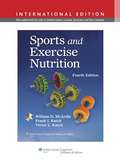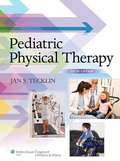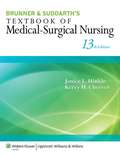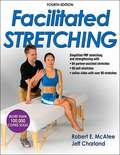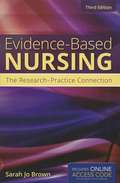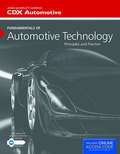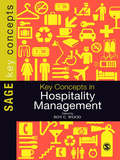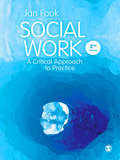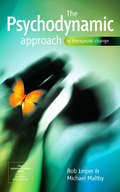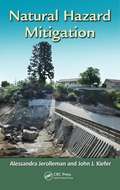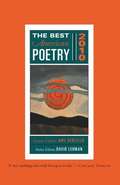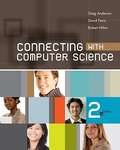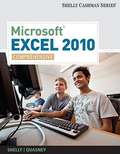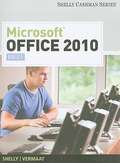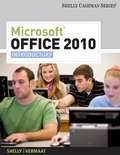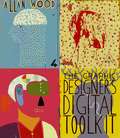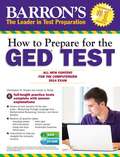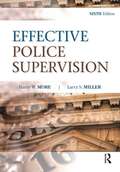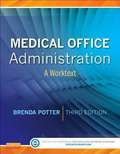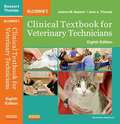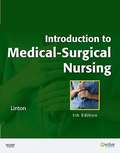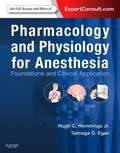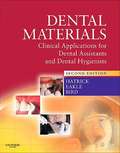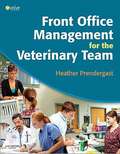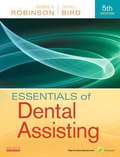- Table View
- List View
Sports and Exercise Nutrition (Fourth Edition)
by William D. Mcardle Frank I. Katch Victor L. KatchThe aim of this book is to provide introductory material for a one semester course in the nutritional and exercise sciences.
Pediatric Physical Therapy Fifth Edition
by Jan Stephen TecklinThis fifth edition of Tecklin’s Pediatric Physical Therapy Pediatric Physical Therapy provides basic medical information regarding common clinical diagnostic categories, followed by coverage of physical therapy evaluation, treatment, and special issues within each diagnostic group.
Textbook of Medical-Surgical Nursing (Thirteenth Edition)
by Janice L. Hinkle Kerry H. CheeverPrepare for medical-surgical nursing practice and success on the NCLEX with Brunner & Suddarth's Textbook of Medical-Surgical Nursing, 13th Edition. A favorite resource for students and practicing nurses for almost a half-century, this book provides comprehensive yet accessible coverage of a broad range of medical conditions while focusing on the nursing process and the nurse's role in caring for and educating patients and families within today's complex health care delivery system. Up-to-date coverage of the health care needs of people with disabilities, nursing research findings, ethical considerations, and evidence-based practice gives you opportunities to refine your clinical decision-making skills. Fully updated and enhanced, this new edition provides a fully integrated solution that promotes clinical judgment, performance, and success on the NCLEX examination and in nursing practice. Key Features in the 13th Edition: NEW! Concept Mastery Alerts clarify difficult concepts, informed by data from Misconception Alert questions in PrepU for Brunner & Suddarth's Textbook of Medical-Surgical Nursing, 12e. NEW! Quality and Safety Nursing Alerts build upon previous edition's Nursing Alerts to highlight issues related to quality and safety nursing care. NEW! The updated unit openers include new Case Studies with QSEN Competency Focus to highlight a competency and related knowledge, skills, and attitudes. Additional information for these case studies related to NANDA-I, NIC, NOC and the nursing process is available online. NEW! Prioritization Questions have been added to the Critical Thinking Exercises. UPDATED! Genetics Charts and Ethical Dilemma Charts have been revised to reflect the latest advances in the field. UPDATED! Critical care information has been updated to further the authors' goal to have the most up-to-date and clinically relevant content on critical care throughout the book. EXPANDED! Expanded coverage of obesity, highlighted with a new icon, focuses on this epidemic health problem in our society. STEAMLINED! The Table of Contents has been reorganized for a more logical sequence and flow. REVISED! The accompanying Study Guide now features reorganized content and revised questions. Nursing Process sections, Plans of Nursing Care, and Critical Care sections More than 2,900 NCLEX-style review questions Assessment Charts, Risk Factor Charts, Guidelines Charts, Genetics in Nursing Practice Charts, Patient Education Charts, Health Promotion Charts, Ethics and Related Issues Charts, and Pharmacology Charts and tables. Gerontologic Considerations sections, Physiology/Pathophysiology figures, and Home Care Checklists Nursing Research Profiles and EBP questions help students learn the importance of evidence-based practice. Concepts in Action Animations bring anatomy, physiology and pathophysiology concepts to life.
Facilitated Stretching (4th Edition)
by Robert McateeFacilitated Stretching, Fourth Edition, remains the most trusted resource for proprioceptive neuromuscular facilitation (PNF) stretching, an effective and easy-to-use method that involves stretching the muscle, contracting it isometrically against resistance, and then stretching it again to increase range of motion. Featuring a full-color interior, streamlined organization, the fourth edition brings PNF stretching beyond the treatment room with the inclusion of techniques for the gym, workout room, and home. The fourth edition offers a visual demonstration of PNF stretching techniques with more than 320 photos and illustrations. It includes these updates: - A full-color interior provides readers with clear images of the techniques discussed - Graphic elements on selected photos highlight the muscles being stretched as well as the isometric effort for the stretcher and the partner - Reorganization streamlines the content into two parts, first focusing on the basics and then covering stretches - Expanded content demonstrates how to incorporate stretches, including strengthening routines, into nontherapy workouts to optimize functional training - An appendix showcases anatomical planes of motion, anatomical terms, and types of joints - Online high-definition video presents both treatment room techniques and simplified PNF stretches for nontherapy settings "Facilitated Stretching, Fourth Edition," examines techniques and guidelines for PNF stretches in a variety of settings. Stretches are demonstrated on a treatment table, mat on the floor, chair, cable-pulley machine, and weightlifting bench. Stretches are grouped according to each joint, and the majority of the stretches include both a partner stretch version and a self-stretch version.
Evidence-Based Nursing: The Research-Practice Connection (Third Edition)
by Sarah Jo BrownEvidence-Based Nursing: The Research-Practice Connection, Third Edition introduces students to research methods and evidence-based practice (EBP). Written in an accessible style, the content moves readers through understanding how research is produced to appraisal at the critical thinking level. Timely information links evidence-based practice to recent work in the Safety and Quality programs that are underway in healthcare and nursing. Key Features:* Offers five common research designs, systematic reviews, and clinical practice guidelines by using a consistent, easy-to-read "Why-How-What" approach. * Exemplar research reports include "Profile and Commentary" that explain results of studies and help students better understand the methodological components of a study Accompanied by Instructor Resources:* Save time with a Test Bank and sample syllabus* Encourage critical thinking using additional learning activities, including discussion questions and small group assignments * Plan classroom lectures using PowerPoint Presentations created by the authorNavigate eFolio Now Available! Navigate eFolio: Evidence-Based Nursing , a fully supported and hosted online learning solution featuring an ebook and course management tools is also available for purchase. Navigate eFolio transforms how students learn and instructors teach by bringing together authoritative and interactive content aligned to course objectives, with student practice activities and assessments, an ebook, and reporting tools. For more information visit go. jblearning. com/nursingef
Fundamentals of Automotive Technology
by Cdx Automotive StaffBrought to you by CDX Automotive, the world's leading provider of interactive automotive training programs, Fundamentals of Automotive Technology: Principles and Practice serves as the centerpiece of an integrated teaching and learning system designed to fully support students and make life easy for instructors. Fundamentals of Automotive Technology: Principles and Practice covers crucial material for career and technical education, secondary/post-secondary, and community college students and provides both rationales and step-by-step instructions for virtually every non-diagnosis NATEF task. Each section provides a comprehensive overview of a key topic area, with real-life problem scenarios that encourage students to develop connections between different skill and knowledge components. Customer service, safety, and math, science, and literary principles are demonstrated throughout the text to build student skill levels. Chapters are linked via cross-reference tools that support skill retention, critical thinking, and problem-solving. Students are regularly reminded that people skills are as important as technical skills in customer service fields. Fundamentals of Automotive Technology: Principles and Practice is filled with tools and pedagogical features designed to maximize student absorption of course materials and reinforce classroom learning. These tools include:* NATEF Tasks, Knowledge Objectives, and Skills Objectives* Case studies that provide an overview of each chapter while stimulating student discussion and building interest in key topics* New pictures and illustrations designed specifically for this text* Skill Drills with written step-by-step instructions and visual summaries of important skills and procedures* Coverage of NATEF Applied Academic skills for math, science, and communication * Tables and figures that present essential data in a format suited to visual learners* Technician Tips that offer advice and on-the-job tricks of the trade* Caring for the Customer sections that highlight essential customer-service skills* Highlighted key terms to maximize retention* Review of key concepts at the end of every chapter to reinforce major concepts * ASE-type questions to prepare students for certification testing.
Key Concepts in Hospitality Management (SAGE Key Concepts series)
by Roy C. WoodThis edited book covers the major concepts you are likely to encounter throughout their study within the hospitality field, giving a comprehensive and up-to-date overview as well as providing engaging everyday examples from around the world. <P><P> A leading figure in the field, Wood has successfully gathered international contributors with direct experience of hospitality management and the hospitality industry as a whole, ensuring both the academic, geographical and practical integrity of the book. <P> Key Concepts in Hospitality Management is written for undergraduate students and those studying short postgraduate or executive education courses in hospitality. It would also be of use to the general academic reader seeking information on the hospitality industry and hospitality management.
Social Work
by Jan FookSocial work is a human profession founded on social justice. It is difficult however to negotiate this in the constantly-changing context of the twenty first century. Now in its' second edition, this book considers the critical tradition of social work and updates it with postmodern thinking. Jan Fook draws on critical reflection to help social workers deliver flexible, responsible and responsive practice and to celebrate the ageless ideals of the profession. Key ideas covered in the text include: - Postmodernism - Critical theories - Critical reflection - Contextuality The author draws on her own experiences, to relate theoretical ideas to real life. Summaries, exercises and further reading are also included in each chapter. The book will be essential reading for all undergraduate students of social work. It will also be a valuable resource for postgraduate students and qualified professionals, who want to revisit the critical tradition of social work.
The Psychodynamic Approach to Therapeutic Change (SAGE Therapeutic Change Series)
by Rob Leiper Michael Maltby`It is well written and well organised and I'm sure it will be of help and interest to researchers and practitioners concerned with the therapeutic action of psychodynamic treatment' - Penelope Waite, Nurturing Potential Change is the central purpose of all counselling and psychotherapy, but how it is conceptualized and worked with varies according to the theoretical approach being used. The Psychodynamic Approach to Therapeutic Change explores the nature of psychological change from the psychodynamic perspective and describes the process through which clients can be helped to come to terms with painful experiences and develop new ways of relating. In the first part of the book, Rob Leiper and Michael Maltby look at therapeutic change in relation to psychological health and maturity. They explore what motivates people to change and also why resistance occurs. The main part of the book outlines the collaborative process that clients and therapist work through to bring about change and highlights the role of the therapist in: ] creating the conditions for clients to express their thoughts, feelings and memories ] developing clients' awareness and understanding of their psychological processes, and ] providing `containment' for the client's psychological projections. The final part of the book sets personal therapeutic change in a wider social context, linking individual change with community and organisational development. Combining core psychodynamic concepts with contemporary thinking, The Psychodynamic Approach to Therapeutic Change provides a lively and up-to-date integration of ideas on the change process which will be of great value to trainees and practicing counsellors and psychotherapists.
Natural Hazard Mitigation
by Alessandra Jerolleman John J. KieferOne of the four core phases of emergency management, hazard mitigation is essential for reducing disaster effects on human populations and making communities more resilient to the impacts of hazards. Presenting an up-to-date look at the changing nature of disasters, Natural Hazard Mitigation offers practical guidance on the implementation and selection of hazard mitigation programs and projects. Based on real-world applications, the book includes case studies that present a thorough explanation of the various issues involved. The contributors describe the value and potential of mitigation efforts and explain how to convince public officials and communities of that value. They also discuss how to better involve the community and uniquely tailor solutions to regional and local situations. The book begins with an overview of the history of hazard mitigation with a focus on the Disaster Mitigation Act of 2000. It examines where hazard mitigation fits into emergency management and addresses some of the challenges that can arise in navigating the various intergovernmental relationships involved in hazard mitigation. The remaining chapters explore: Public-private partnerships for hazard mitigation at the local level The role currently played by the private sector and how communities can best make use of contractors How to maximize the use of the National Flood Insurance Program and the Community Ratings System Risk communications as a key component of encouraging hazard mitigation Legal issues relevant to hazard mitigation Ways to actively engage the community and how to advocate for hazard mitigation policy How state and local governments can promote and fund mitigation without utilizing federal dollars The challenges associated with volunteers and how to best make use of this resource The area analysis as an innovative means of addressing flood risk at the block or neighborhood level The book includes learning objectives, key terms, and end-of-chapter questions to enhance comprehension. It concludes with a discussion of tools that local practitioners can use and provides an appendix with additional links and resources. This volume is an essential reference for both students and professionals in the ongoing effort to better prepare communities against the effects of natural hazards.
The Best American Poetry 2010
by Amy Gerstler David LehmanAMY GERSTLER'S COMMITMENT TO INNOVATIVE POETRY that conveys meaning, feeling, wit, and humor informs the cross section of poems in the 2010 edition of The Best American Poetry. The works collected here represent the wealth, the breadth, and the tremendous energy of poetry in the United States today. Featuring poems from some of our country's top bards, including John Ashbery, Anne Carson, Louise GlÜck, Sharon Olds, and Charles Simic,The Best American Poetry 2010also presents poems that poignantly capture the current moment, such as the sonnets John Updike wrote to chronicle his dying weeks. And there are exciting poems from a constellation of rising stars: Bob Hicok, Terrance Hayes, Denise Duhamel, Dean Young, and Elaine Equi, to name a very few. The anthology's mainstays are in place: It opens with series editor David Lehman's incisive foreword about the state of American poetry and has a marvelous introduction by Amy Gerstler. Notes from the poets, illuminating their poems and their writing processes, conclude this delightful addition to a classic series.
Connecting with Computing Science
by Greg Anderson David Ferro Robert HiltonWritten for the beginning computing student, this text engages readers by relating core computer science topics to their industry application. The book is written in a comfortable, informal manner, and light humor is used throughout the text to maintain interest and enhance learning. All chapters contain a multitude of exercises, quizzes, and other opportunities for skill application.
Microsoft Excel 2010, Comprehensive
by Gary B. Shelly Jeffrey J. Quasney Steven M. Freund Raymond E. Enger Mali B. JonesMicrosoft Office Excel 2010, Comprehensive provides a project-based, step-by-step approach to teach students Microsoft Excel 2010 skills.
Microsoft Office 2010: Brief
by Gary B. Shelly Misty E. VermaatAs one of the books in The Shelly Cashman Series® on computer education, Microsoft Office 2010: Brief provides a project-based, step-by-step approach to teaching the Office 2010 applications and offers a number of new features and approaches, which improve student understanding retention transference, and skill in using Office 2010 programs.
Microsoft Office 2010: Introductory (Shelly Cashman Series)
by Gary B. Shelly Misty E. VermaatMicrosoft Office 2010: Introductory provides a project-based, step-by-step approach to teaching the Office 2010 applications.
The Graphic Designer's Digital Toolkit
by Allan B. WoodBeing a successful graphic designer today requires more than knowing the essential features of industry-standard software applications. It also requires an understanding of how to integrate these programs into a seamless whole while producing work that conforms to design principles and client expectations.
How to Prepare for the GED Test
by Christopher Sharpe Joseph ReddyThe 2014 GED exam has been revised extensively to reflect the world we live in today. The most noticeable change is that the test is now computer based--a transition that requires test-takers to have strong typing and computer skills. <P><P> The new exam covers additional topics in the Math and Science sections and includes "blended" subject matter within the sections, meaning test-takers will see science questions that require math to produce a numerical answer or social studies questions that require essay-writing skills and so forth. <P><P>Test-takers will also find all question types used on the new computer format. With such comprehensive changes in store for test-takers, it is fitting for Barron's to offer a book based on the 2014 exam. The new "How to Prepare for the GED Test" offers test-takers a guided approach to taking and passing the exam by building on the skills they already have. <P><P>Test-takers will benefit from the book's extensive subject reviews that cover all four of the new test sections: Social Studies Science Reasoning through Language Arts Mathematical Reasoning The book also includes diagnostic tests and two full-length practice exams with all questions answered and explained.
Effective Police Supervision
by Larry S. Miller Harry W. MoreGood police officers are often promoted into supervisory positions with little or no training for what makes a good manager. Effective Police Supervision is a core text used in college-level classes on supervisory practices in criminal justice. This popular book combines behavioral theory with case studies that allow the reader to identify and resolve personal and organizational problems. It provides readers with an understanding of the group behaviors and organizational dynamics, with a focus on effectiveness as well as proficiency, and on how a supervisor can help to create an effective organization. This book is also a vital tool in the preparation of police officers for promotional exams. NEW THIS EDITION This revised and updated edition has a new chapter Homeland Security and Terrorism -- A Changing Role. New material has been added throughout the textbook on the following topics: characteristics of an effective coach, mentoring, work values, unions, dealing with change, supervisory styles, empowerment, SARA, identifying stakeholders, dealing with Limited English Proficient individuals, intercultural communication, and equity theory. The case studies and references have been thoroughly updated and expanded. Each chapter opens with a case study to illustrate the concept and includes key terms. Contains a new chapter on homeland security and terrorism and how they are changing the role of the police supervisor. Used nationwide for police promotional exams.
Medical Office Administration, Third Edition
by Brenda A. PotterMedical Office Administration, Third Edition, explores the career of a medical administrative assistant, beginning with an examination of the profession and the health care industry, and continuing on to the daily responsibilities of a medical administrative assistant. The text is organized into five units and 16 chapters which are designed to prepare the student for employment as a medical administrative assistant.
McCurnin's Clinical Textbook for Veterinary Technicians (Eighth Edition)
by Joanna M. Bassert John ThomasA fundamental text in the field of veterinary technology, McCurnin's Clinical Textbook for Veterinary Technicians, 8th Edition has the trusted content, simplified layout, and novel study tools every Vet Tech needs. Sections on small and large animals, birds, reptiles, and small mammals embrace every aspect of the veterinary field, while case presentations of actual patient situations link information to relevant, real-life scenarios. Vet Tech Threads offer helpful pedagogical aids such as introductions, suggested readings, boxed Technician Notes, learning objectives, chapter outlines and key terms. Large animal care integrated throughout the book with medical records, dentistry, physical examination, surgical instrumentation, and more. Step-by-step instructions and photographs makes information readily accessible in emergency and clinical situations. Birds, reptiles, and small mammals chapter keeps you up-to-date with care and treatment for these increasingly popular pets. Chapters on pharmacology, pain management, restraint, and veterinary oncology offer a broader understanding of the responsibilities of a technician. NEW! Chapter on fluid therapy and transfusion medicine, a critical aspect of veterinary technology. NEW! Introduction to the concept of the Technician Practice Model ensures that excellent nursing care is provided to each and every patient. NEW! Added content on electrocardiography included in the Emergency Nursing chapter.
Introduction to Medical-Surgical Nursing (Fifth Edition)
by Adrianne Dill LintonWith just the right level of information to equip you to effectively care for adults and older adults, Linton''s Introduction to Medical-Surgical Nursing, 5th Edition is the leading LPN/LVN text in its field. Covering both med-surg and psychiatric mental health conditions and disorders, it addresses your role in a variety of care settings, emphasizes culturally competent care and holistic nursing, and thoroughly covers all relevant NCLEX-PN Test Plan content. Abundant real-life case studies clearly show how to apply what you''ve learned to clinical practice. Features separate chapters on common, high-profile disorders (including hypertension, diabetes, and shock), providing an in-depth understanding for patient care. Offers foundational units on basic concepts related to the health care system, care settings, the nursing process, leadership, nutrition, the older adult, growth and nutrition, legal/ethical considerations, evidence-based nursing care, and many more essential topics, avoiding repetition later in the text Includes a separate, comprehensive unit on the older adult and related disorders - no other LPN/LVN med-surg text has as much coverage of this primary patient group. Includes a separate, comprehensive unit on psychosocial responses to illness, psychiatric disorders, and substance abuse - eliminating the need for a separate psychiatric mental health nursing text. Emphasizes content related to the NCLEX-PN Test Plan, including health promotion, nutrition, legal/ethical issues, HIPAA, and prevention of medication/medical errors. Offers in-depth pharmacology coverage: the Pharmacology Tutorial covers drug classifications, how drugs work, and nursing responsibilities; Pharmacology Capsules boxes provide medication information, precautions for use, interactions, and side/adverse effects; and Pharmacology and Medications tables in body systems chapters include classification, use/action, side/adverse effects, and nursing interventions - all with the goal of reducing medication errors on the job and equipping you to pass the NCLEX exam. Assists with assignment and supervision, helping you assign tasks to nurse assistants, patient care techs, and unlicensed assistive personnel, and making sure you understand the difference between delegation, management, supervision, and assignment of tasks on the health care team. Features Diagnostic Tests and Procedures tables for a quick reference to MRI, CT, Doppler flow, lumbar puncture tests for neurologic disorders, and much more. Highlights timely information with Health Promotion boxes, Cultural Considerations boxes, Nutrition Considerations boxes, and Complementary and Alternative Therapies boxes. Provides bulleted lists of nursing instructions for Patient Teaching Plans, stressing the role and responsibility of the LPN/LVN to reinforce patient education. Provides consistent Nursing Care Plans that reinforce the nursing process and focus on critical thinking, and Put on Your Thinking Cap Critical Thinking boxes encourage you to pause and consider the practical implications of what you have just read. Highlights safety and risk factors with a new Safety Considerations icon, alerting you to potential risks in the clinical setting. Emphasizes evidence-based practice, providing specific examples of how scientific evidence can justify and support patient care. Offers a unique focus on prioritization throughout, with top priorities for each major disorder emphasized in all nursing care sections, to help you better prepare for the NCLEX exam. Get Ready for the NCLEX-PN Examination! includes Key Points, Review Questions, and Case Studies that address the NCLEX Client Needs categories of Safe and Effective Care Environment, Physiological Integrity, Psychosocial Integrity, and Health Promotion and Maintenance. An excellent review for course assessments and the NCLEX exam!
Pharmacology and Physiology for Anesthesia
by Hugh C. Hemmings Talmage D. EganBetter understand the complexities of pharmacology and physiology relevant to your practice with the brand-new medical reference book, Pharmacology and Physiology for Anesthesia. Drs. Hugh Hemmings and Talmage Egan provide the clinical insights you need to effectively administer anesthesia, ensuring patient safety and the most optimal outcomes. Access comprehensive, continually updated research on the physiology of organ systems and clinical topics in the pharmacology of anesthetic drugs. Quickly and easily reference the information you need through user-friendly tables, figures, and algorithms, all presented in lavish full color throughout. Understand the molecular mechanism of drug actions and identify key drug interactions that may complicate anesthesia with dedicated sections on these key areas. Search the text and download images online at Expert Consult. Build a thorough knowledge of pharmacology and physiology focused on clinical practice
Dental Materials: Clinical Applications For Dental Assistants and Dental Hygienists (Second Edition)
by Carol Dixon Hatrick W. Stephen Eakle William F. BirdWith this hands-on resource, you will learn the most current methods of placing -- or assisting in the placement -- of dental materials, and how to instruct patients in their maintenance. Dental Materials uses step-by-step procedures to show how to mix, use, and apply dental materials within the context of the patient's course of treatment. Expert authors Carol Hatrick, W. Stephan Eakle, and William F. Bird enhance this edition with four new chapters, along with coverage of newly approved materials and esthetic tools including the latest advances in bleaching and bonding. A new companion Evolve website lets you practice skills with challenging exercises! Procedure boxes include step-by-step instructions for common tasks. Procedural icons indicate specific guidelines or precautions that need to be followed for each procedure. End-of-chapter review questions help you assess your retention of material, with answers provided in an appendix. End-of-chapter case-based discussions provide a real-life application of material covered in the chapter. Clinical tips and precautions emphasize important information, advice, and warnings on the use of materials. Key terms are defined at the beginning of each chapter, bolded within the chapter, and defined in the glossary. Objectives help you focus on the information to gain from each chapter. Introductions provide an overview of what will be discussed in each chapter. Summary tables and boxes make it easy to find and review key concepts and information. Full-color photos and illustrations show dental materials and demonstrate step-by-step procedures, including new clinical photos of bleaching and bonding. New Dental Ceramics chapter addresses the growth in esthetic dentistry by discussing porcelain crowns, inlays, and veneers and the process of selecting the proper shade. New Dental Amalgam chapter discusses the use of metal - still the most commonly used material in restorative and corrective dentistry. New Casting Alloys, Solders, and Wrought Metal Alloys chapter breaks down specific types of combination metals and the procedures in which they are used. New Dental Implants chapter covers several different types of implants as well as how to instruct patients on hygiene and home care of their implant(s). The Materials Handling section reflects the new Infection Control Environment (ICE) standards and all approved ADA methods for the disposal of surplus materials. A companion Evolve website includes exercises to help you identify images and master procedures, plus competency skill sheets to assess your understanding.
Front Office Management for the Veterinary Team
by Heather PrendergastThe only book of its kind, Front Office Management for the Veterinary Team focuses on the day-to-day duties of the veterinary team. It offers a complete guide to scheduling appointments, billing and accounting, communicating effectively and compassionately with clients, managing medical records, budgeting, marketing your practice, managing inventory, using outside diagnostic laboratory services, and much more. Written by Heather Prendergast, RVT, CVPM, this manual simplifies essential tasks with step-by-step instructions! Exercises on the Evolve website offer additional practice with front office tasks. Interactive working forms give you experience completing sample checks, deposit slips, patient history forms, and incident reports. The latest information on electronic banking and tax forms ensures that you adhere to the most current financial guidelines. What Would You Do/Not Do boxes provide scenarios to expose you to real-life situations that occur in veterinary practice and guide you through to an appropriate resolution. Review questions test your understanding of concepts presented in each chapter. Practice Point boxes highlight practical information to remember while on the job. Veterinary Practice and the Law boxes provide essential information about laws that you must know in order to run an ethical practice and to protect the practice. Key terms and learning objectives guide you through study of the most important content.
Essentials of Dental Assisting, 5th Edition.
by Debbie S. Robinson Doni L. BirdThis practical resource focuses on the core clinical skills and knowledge you need to become a practicing dental assistant. And includes step-by-step procedures, application exercises, and a wealth of pedagogical aids ensure that you master all the necessary skills.
